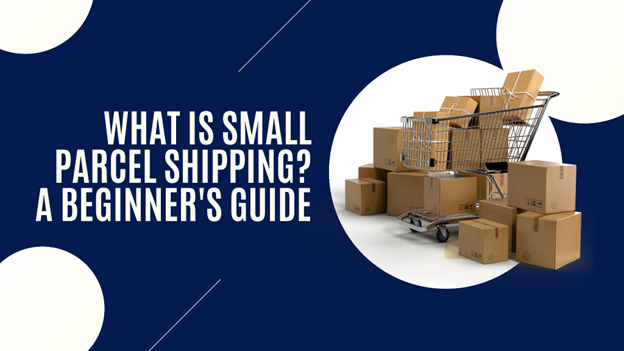What is Small Parcel Shipping? A Beginner’s Guide
Introduction to Small Parcel Shipping
In today’s fast-paced, digital-driven world, the logistics of getting products from sellers to buyers have become more sophisticated and efficient. Among the numerous shipping options available, small parcel shipping stands out as a vital method for businesses and consumers alike. This comprehensive guide will take you through the essentials of small parcel shipping, highlighting its workings, benefits, and how EFEX can streamline the process for your business.
Understanding Small Parcel Shipping
Small parcel shipping refers to the transportation of packages that are relatively small and lightweight. These parcels typically weigh less than 150 pounds and are individually packaged, labeled, and transported to their final destination via carriers like UPS, DHL, and FedEx. Small parcel delivery is crucial for e-commerce businesses, retail stores, and individuals who need to send items efficiently and cost-effectively.
- Package Size and Weight: Small parcel shipping is designed for packages that are compact and lightweight. This makes it an ideal solution for shipping products such as books, electronics, clothing, and other consumer goods.
- Carrier Network: Small parcels are handled by a network of carriers that specialize in quick and reliable delivery services. Companies like UPS, DHL, and FedEx have extensive networks that allow for fast and efficient shipping across various regions.
- Delivery Speed: Small parcel shipping offers various delivery speed options, including same-day, next-day, two-day, and standard delivery. This flexibility allows businesses to meet different customer needs and preferences.
- Tracking Capabilities: Advanced tracking technology allows shippers and recipients to monitor the status of their parcels in real-time. This ensures transparency and enhances the overall customer experience.
How does small parcel shipping work?
The process of small parcel shipping involves several key steps to ensure that packages are delivered efficiently and on time. Here’s a breakdown of how it works:
- Packaging: The first step in small parcel shipping is proper packaging. Items are securely packed in boxes or envelopes to protect them during transit. It’s important to use the right packaging materials to prevent damage.
- Labeling: Each package is labeled with the recipient’s address, the sender’s information, and a tracking number. This tracking number is crucial for monitoring the package’s journey from origin to destination.
- Carrier Selection: Depending on the destination, delivery time, and cost considerations, a suitable carrier is chosen. Popular carriers for small parcel shipping include UPS, FedEx, DHL, and USPS.
- Pickup or Drop-off: Once the package is ready, it can either be dropped off at a carrier’s location or scheduled for pickup. Many carriers offer convenient pickup services for businesses and individuals.
- Transit: The package is then transported through the carrier’s network. This may involve multiple modes of transportation, including trucks, planes, and sorting facilities.
- Delivery: Upon reaching the destination city, the package is sorted and delivered to the recipient’s address. Most carriers offer various delivery options, such as standard, expedited, or overnight shipping.
- Tracking and Confirmation: Throughout the shipping process, the tracking number allows both the sender and the recipient to monitor the package’s progress. Once delivered, confirmation of receipt is often provided.
Comparing Small Parcel and Freight Shipping
While both small parcel and freight shipping are methods to transport goods, they differ significantly in scale, cost, and process. The table below highlights the key differences between small parcel shipping and freight shipping based on various factors such as size and weight, speed, handling, and tracking capabilities.
| Factor | Small Parcel Shipping | Freight Shipping |
| Size and Weight | Ideal for packages under 150 pounds | Suitable for large, bulky, or heavy shipments exceeding 150 pounds |
| Speed | Typically faster with options for next-day, two-day, or standard shipping | Generally slower due to the volume and logistics involved |
| Handling | Individual handling, making it suitable for delicate or high-value items | Often involves pallets or containers, with goods transported in bulk |
| Tracking | Enhanced tracking capabilities with real-time updates | Less granular tracking compared to small parcel shipments |
| Cost | More cost-effective for smaller, individual shipments | More economical for larger, bulk shipments |
| Flexibility | Greater flexibility with a variety of shipping options | Less flexible, often requiring advanced planning |
| Environmental Impact | Lower environmental impact due to smaller shipments and optimized routes | Higher environmental impact due to larger vehicles and bulk transportation |
| Delivery Frequency | More frequent deliveries with daily or multiple times per week options | Less frequent, often scheduled weekly or bi-weekly |

Why are companies using small parcel shipping?
Companies across various industries are increasingly turning to small parcel shipping for several reasons:
It’s easier to track
One of the primary advantages of small parcel shipping is the ease of tracking. Each package is assigned a unique tracking number, allowing both the sender and the recipient to monitor its progress in real-time. This transparency helps businesses provide better customer service by keeping customers informed about the status of their orders.
It’s cheaper than freight shipping
For businesses that need to ship smaller quantities of goods, small parcel shipping is often more cost-effective than freight shipping. Carriers offer competitive rates for small parcels, and businesses can take advantage of volume discounts and shipping agreements to reduce costs further.
It’s better for the environment
Small parcel shipping can also be more environmentally friendly compared to freight shipping. Carriers optimize their routes and use fuel-efficient vehicles, reducing the carbon footprint associated with transportation. Additionally, the use of smaller packaging materials and the ability to consolidate shipments contribute to a more sustainable shipping process.

Shipping Rates for Small Packages
Shipping rates for small packages can vary widely depending on several factors. Understanding these factors can help businesses choose the most cost-effective options and optimize their shipping strategies. Here are the key elements that influence shipping rates:
- Carrier:
- Pricing Structures: Different carriers have unique pricing structures. For instance, UPS small package shipping might have different rates compared to DHL small parcel services. Each carrier may offer various services and pricing tiers, making it essential to compare options.
- Carrier-Specific Discounts: Carriers often provide discounts based on shipping volume and long-term partnerships. Businesses that frequently ship with a particular carrier can negotiate better rates.
- Sample Rates:
- UPS: For a 5-pound package, standard ground shipping within the U.S. typically costs around $10-$15. Next-day air delivery can cost $50-$70.
- FedEx: Similar to UPS, ground shipping for a 5-pound package ranges from $9-$14. FedEx Express Saver (3-day delivery) costs approximately $30, while overnight shipping can exceed $60.
- DHL: International shipping for a 5-pound package can cost $50-$100, depending on the destination. Domestic rates are comparable to UPS and FedEx for similar services.
- Distance:
- Domestic vs. International: Shipping rates are significantly influenced by the distance the package needs to travel. Domestic shipments are generally less expensive than international ones.
- Zones and Regions: Carriers use zone-based pricing for domestic shipments, where the cost increases with the distance between the origin and destination zones. Understanding these zones can help in estimating shipping costs more accurately.
- Speed:
- Express Services: Expedited services such as next-day or two-day delivery are more expensive than standard shipping options. These services are ideal for urgent deliveries but come at a premium.
- Standard Shipping: For less time-sensitive shipments, standard shipping options are more economical. These services usually have longer delivery windows but offer substantial cost savings.
- Weight and Dimensions:
- Dimensional Weight Pricing: Carriers use dimensional weight (DIM) pricing to calculate shipping costs based on the package’s size and weight. Larger and heavier packages generally cost more to ship.
- Sample Rates:
- UPS: A 10-pound package shipped via ground service costs around $20-$25, while a 20-pound package can cost $30-$40.
- FedEx: For the same 10-pound package, FedEx ground service rates are about $18-$23. A 20-pound package might cost $28-$35.
- USPS: Priority Mail for a 5-pound package costs around $10-$20, depending on the distance. For larger packages, USPS Flat Rate Boxes offer predictable pricing, with the large box costing around $21.90 regardless of weight.
- Special Services:
- Insurance: Adding insurance to a package can increase the overall shipping cost. For example, insuring a package valued at $500 might add $5-$10 to the shipping fee.
- Signature Confirmation: Requiring a signature upon delivery typically costs an additional $2-$5.
- Weekend Delivery: Weekend delivery services, offered by carriers like FedEx and UPS, can add $15-$20 to the shipping cost.
How EFEX Facilitates Small Parcel Shipping
EFEX is a logistics company dedicated to helping businesses streamline their small parcel shipping processes. EFEX provides several benefits to businesses based on its extensive industry experience and advanced technology:
- Carrier Partnerships and Negotiated Rates:
- Partnerships: EFEX collaborates with major carriers such as UPS, FedEx, DHL, and USPS. This allows businesses to access a broad range of shipping options and services.
- Negotiated Rates: Through its established relationships, EFEX secures significant discounts on shipping rates. Businesses can save up to 30% on shipping costs compared to standard rates, enabling more competitive pricing and improved profit margins.
- Technology Integration:
- Advanced Shipping Software: EFEX offers state-of-the-art shipping software that integrates seamlessly with e-commerce platforms like Shopify, Magento, and WooCommerce. This integration simplifies order processing, label generation, and tracking.
- Automation: Automated processes reduce manual errors and save time. Businesses can automate shipping rules, carrier selection, and notifications, ensuring a smooth and efficient workflow.
- Volume Discounts and Cost Savings:
- Consolidation Services: EFEX could help businesses take advantage of volume discounts by consolidating shipments . For instance, businesses shipping over 500 packages per month can see cost reductions of up to 20%.
- Bulk Shipping Options: EFEX offers bulk shipping solutions for companies with high shipping volumes, further lowering the cost per package.
- Expert Support and Consultation:
- Dedicated Account Managers: EFEX provides businesses with dedicated account managers who offer personalized support and guidance. These experts help optimize shipping strategies, select the best carriers, and manage complex logistics challenges.
- Customer Support: EFEX’s customer support team is available 24/7, ensuring that any issues or questions are promptly addressed.
- Sustainability Initiatives:
- Eco-Friendly Packaging: EFEX offers sustainable packaging options, including recyclable and biodegradable materials. This helps businesses reduce their environmental footprint and appeal to eco-conscious customers.
- Carbon Offset Programs: Through partnerships with environmental organizations, EFEX provides carbon offset programs that allow businesses to compensate for their carbon emissions. For example, businesses can offset 100% of their shipping emissions for a nominal fee, contributing to global reforestation projects.
- Data-Driven Insights:
- Analytics and Reporting: EFEX provides comprehensive analytics and reporting tools that give businesses insights into their shipping performance. These tools help identify cost-saving opportunities, track delivery times, and monitor carrier performance.
- Custom Reports: Businesses can generate custom reports to analyze specific metrics, such as shipping costs by carrier, delivery times by region, and package weight distribution.

Conclusion
Small parcel shipping is an essential component of modern logistics, providing a cost-effective, efficient and environmentally friendly way to send small packages. Businesses can optimize their shipping strategy, reduce costs and improve customer satisfaction by understanding small parcel shipping services. From there, the business development and growth process becomes even simpler by leaving logistics to the experts.
Whether you’re a small business looking for the cheapest way to ship for small business or an established enterprise aiming to optimize your shipping operations, small parcel shipping is a valuable tool. And with the support of EFEX, navigating the complexities of small parcel delivery becomes simpler, more cost-effective, and more efficient. For e-commerce businesses, fulfillment services for e-commerce businesses are crucial. EFEX’s advanced integration with e-commerce platforms ensures that orders are processed efficiently and delivered promptly, providing an excellent customer experience.







